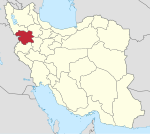Darai Rockshelter
The Darian Dam Archeological Salvage Program (DDASP) was planned by the Iranian Center for Archaeological Research before flooding the Darian Dam reservoir. This archaeological program, under the general direction of Fereidoun Biglari, has conducted several seasons of archaeological surveys and excavations within the area of the reservoir that led to the discovery of a number of important Paleolithic and more later sites.
Archaeology
When discovered, it was partially collapsed and eroded by the Sirwan River. The site contained Middle Paleolithic archaeological deposits of about 2.30 m thick along back walls. Large-scale excavations at the site yielded two main Middle Paleolithic cultural layers. Numerous fireplaces and rich faunal and lithic assemblages were found during the excavation. The faunal assemblages are dominated by goat/sheep that show burning, cut marks, and other anthropogenic modifications. Based on the preliminary techno-typological study of the Darai lithic assemblage, the Middle Paleolithic flake-based industry of Darai generally resembles the Zagros Mousterian. The Levallois and discoid methods have been used to produce blanks for tools such as Mousterian points and side scrapers. It seems Darai was a focal point for Neanderthal habitation that resulted in the concentration of a thick accumulation of archaeological deposits in this location.
